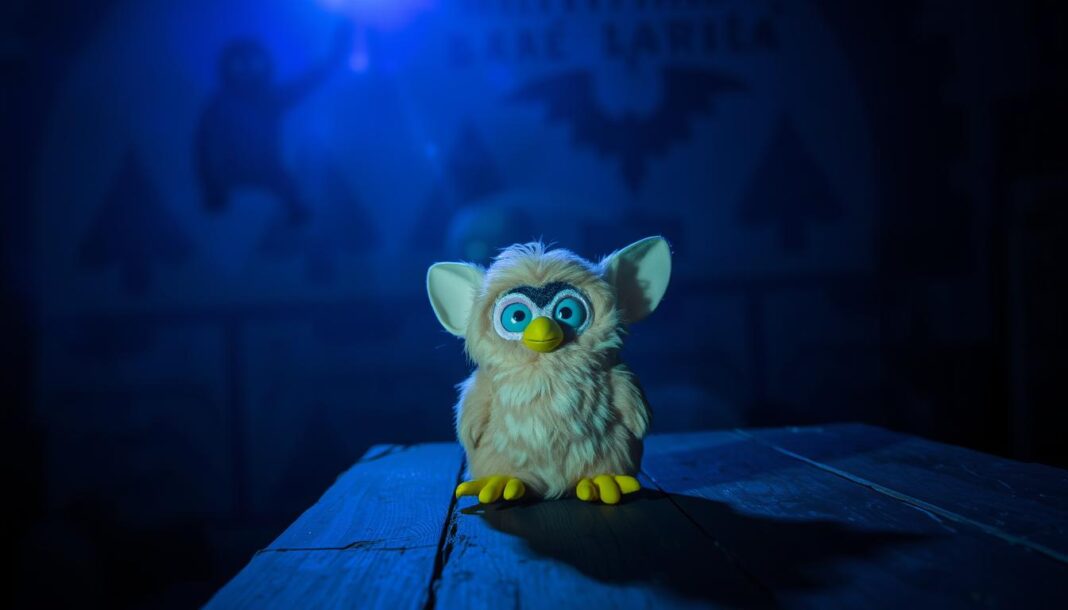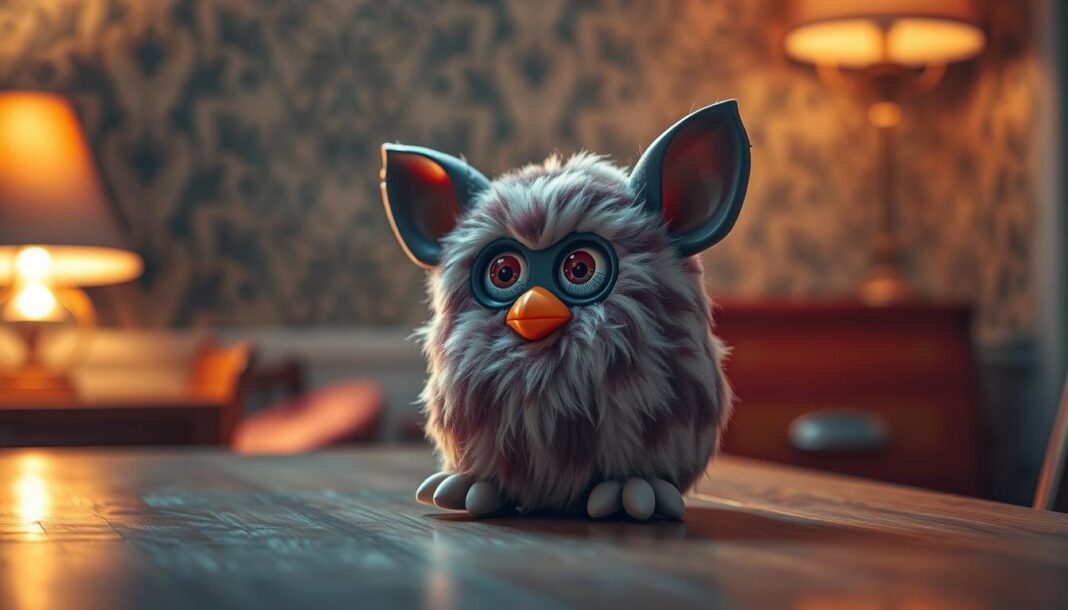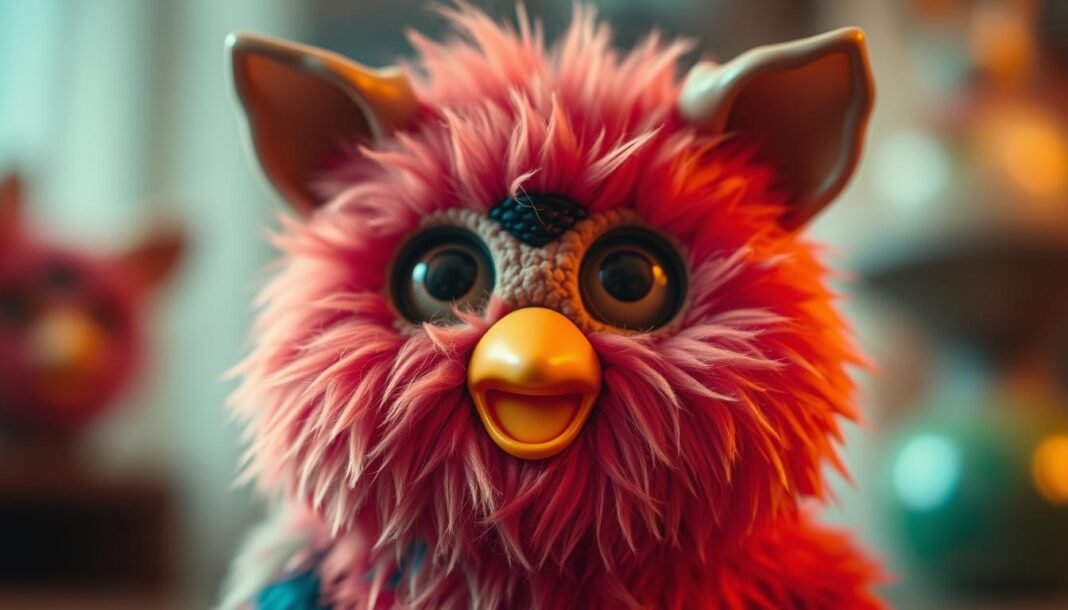Since their debut in 1998, Furbies have captured hearts and sparked curiosity. Over 58 million of these interactive toys have found homes worldwide, blending charm with a hint of mystery. Yet, their legacy isn’t just about playtime—it’s also filled with eerie tales and unanswered questions.
Stories of Furbies speaking without batteries or uttering unsettling phrases like “feed me” have gone viral. These incidents have fueled debates about whether these behaviors are mere glitches or something more. Even the NSA took notice, banning them from Pentagon facilities in 1999 over recording concerns.
Today, Furbies are making a comeback with Hasbro’s 2023 touch-responsive models. Social media buzzes with modern interpretations of their quirky charm. But the question lingers: are these toys simply misunderstood, or do they carry a darker edge? Dive into the history and decide for yourself.
The Origins of Furbies: From Cute to Creepy
The late ’90s introduced a toy that became a cultural icon, sparking both joy and unease. Priced at $35, the original Furby flew off shelves, with resale prices skyrocketing to $300+ during shortages. By 1999, over 14 million units had been sold, cementing its place in toy history.
One of the most intriguing features was its infrared communication. This allowed multiple Furbies to “talk” to each other, creating a “hive mind” effect. Families were both fascinated and slightly unnerved by this behavior.
Interestingly, the Furby’s design drew comparisons to the Gremlins movie. Both featured fuzzy creatures with a dark edge, adding to the toy’s mystique. Collectors today treasure rare models like the Bejeweled Furby, which can fetch up to $100,000.
Over the years, the Furby has evolved significantly. From the 24-color Furby Babies in 1999 to the 2012 models with LCD eyes and 14-language capabilities, it has remained a beloved toy. The 2023 voice-activated models continue this legacy, blending nostalgia with modern technology.
| Year | Model | Key Features |
|---|---|---|
| 1998 | Original Furby | Infrared communication, basic phrases |
| 1999 | Furby Babies | 24 colors, simplified design |
| 2012 | Furby 2012 | LCD eyes, 14 languages |
| 2023 | Voice-Activated Furby | Touch-responsive, modern tech |
For those curious about the Furby’s enduring appeal, this article dives deeper into its unique charm. Whether you see it as a toy or a cultural phenomenon, the Furby’s story is one of innovation and intrigue.
Why Are Furbies So Creepy? The Science Behind the Fear
The uncanny nature of Furbies has sparked debates about their design and psychological impact. Their blend of charm and eeriness taps into deep-seated instincts, making them both fascinating and unsettling. Let’s explore the science behind why these toys evoke such strong reactions.
Predatory Eyes and the Uncanny Valley
One of the most striking features of Furbies is their eyes. With 20mm diameter pupils, they are twice the size of an average human’s. This design mimics the forward-facing eyes of predators, triggering a subconscious alertness in people. Combined with their 50% human-like appearance, Furbies fall into the uncanny valley, a zone where something feels almost human but not quite, causing discomfort.
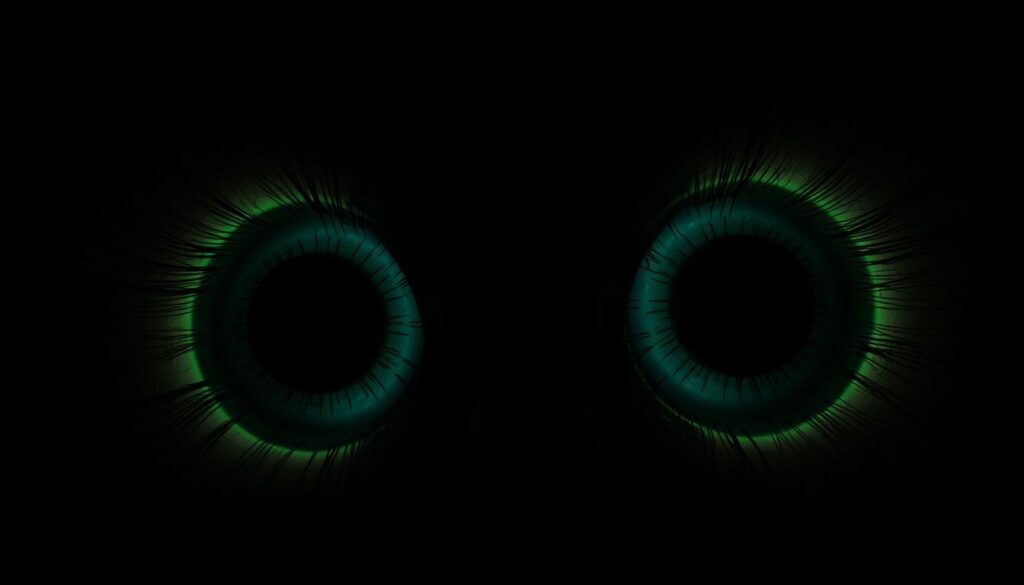
The Illusion of Autonomy: Furbies’ “Mind”
Furbies’ ability to perform over 600 reactions and 10 songs creates the illusion of autonomy. This can be unsettling, especially when they seem to act independently. A parent once shared, “Our Furby laughed at 3 AM without batteries.” This phenomenon, known as the Furby Korean effect, occurs when random sounds are interpreted as meaningful language, further blurring the line between toy and living thing.
How Furbies Trigger Primal Fear Responses
Jerky movements and unexpected behaviors can activate our fight-or-flight response. An MIT study found that autonomous-seeming toys increase cortisol levels by 18%, heightening stress. Evolutionarily, this reaction stems from a need to detect potential threats. Furbies’ unpredictable actions tap into this primal instinct, making them feel more alive—and more unsettling—than they truly are.
| Feature | Impact |
|---|---|
| Predatory Eyes | Triggers alertness and discomfort |
| Autonomous Behavior | Creates illusion of life |
| Jerky Movements | Activates primal fear responses |
For those curious about managing their Furby’s behavior, this guide offers practical tips. Whether you see them as playful companions or eerie creations, understanding the science behind their design can help demystify their charm—and their creepiness.
Paranormal Claims: Are Furbies Haunted?
Over the years, Furbies have become more than just toys—they’ve sparked tales of the paranormal. From eerie behaviors to myths in popular culture, these fuzzy companions have left many wondering if there’s more to them than meets the eye. Let’s explore the stories that have fueled these claims.
Ghostly Behaviors: Tales of Furbies Acting on Their Own
One of the most unsettling aspects of Furbies is their ability to act independently. A Reddit user shared a story about their Furby screaming “cockadoodledoo” during a math test—without batteries. Another account describes a Furby laughing in the middle of the night, sending chills down the spine of its owner.
These stories often involve Furbies performing actions long after their power source is removed. While some attribute this to paranormal activity, tech experts explain it’s likely due to poorly shielded servos or residual charge in capacitors. Still, the mystery persists.
The Myth of Possessed Furbies in Popular Culture
Furbies have also made their mark in horror culture. Etsy shops like “FurbishHorrors” sell zombie Furbies with real teeth, adding to their creepy reputation. These creations draw comparisons to Annabelle, the infamous haunted doll from horror cinema.
The 2018 long Furby trend further cemented their place in modern mythology. With over 1,000 sales on Etsy, these elongated versions became symbols of both nostalgia and fear. Their bizarre appearance fueled countless creepypastas, including the infamous “burn pit scream” account.
Batteries or Beyond? The Mystery of Powerless Furbies
Many paranormal claims center around Furbies operating without batteries. While it’s easy to jump to supernatural conclusions, the truth lies in technology. Furbies use capacitors that store a 10-15 minute charge, allowing them to function briefly after power is removed.
Tiger Electronics, the original manufacturer, has repeatedly denied claims of Furbies being haunted or spying devices. Yet, the allure of these stories continues to captivate. Whether you see them as a friend or a monster, Furbies remain a fascinating blend of innovation and mystery.
| Claim | Explanation |
|---|---|
| Speaking without batteries | Capacitors store residual charge |
| Laughing at night | Poorly shielded servos |
| Independent actions | Random sound interpretation |
For those curious about managing their Furby’s behavior, this guide offers practical tips. Whether you believe in the paranormal or not, Furbies continue to intrigue and unsettle in equal measure.
Modern Myths: Furbies in the Digital Age
In today’s digital age, Furbies have found a new life online, blending nostalgia with modern myths. These toys, once a staple of the ’90s, have become viral sensations, sparking fresh tales of their eerie charm. From TikTok trends to Etsy creations, they continue to captivate and unsettle in equal measure.
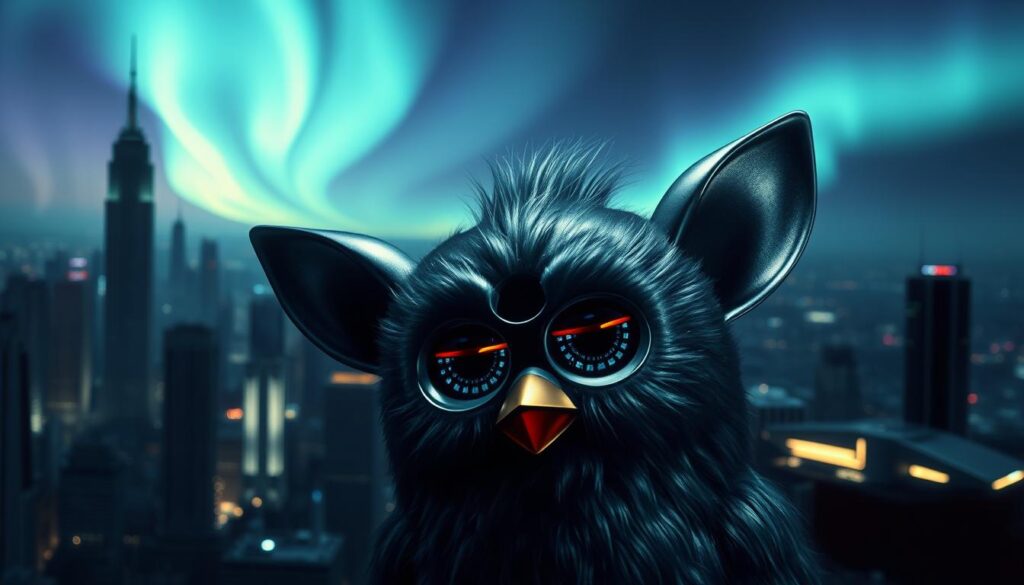
Viral Stories and Social Media’s Role
Social media platforms like TikTok have played a huge role in reviving Furbies. With over 214 million views on #FurbyTok, these toys have become a source of endless entertainment and intrigue. Viral stories range from Furbies syncing with smart home devices to ordering 87 toy coffins via Alexa. These tales highlight their uncanny ability to blend humor with a touch of creepiness.
Etsy sellers have also capitalized on this trend, offering customized “haunted” Furbies. One seller reportedly earns $3,000 a month by creating unique, eerie versions of these toys. This blend of creativity and nostalgia has turned Furbies into more than just toys—they’re now cultural icons.
The Long Furby Trend: A New Wave of Creepiness
The long Furby trend has taken the internet by storm. These elongated versions, often reaching 4 feet in length, feature reptile tails and other bizarre modifications. Instagram accounts like LongFurbyFam showcase these creations, blending nostalgia with a new wave of creepiness.
This trend has sparked a mix of fascination and fear. For some, long Furbies are a nostalgic throwback. For others, they’re a reminder of the unsettling nature of these toys. Regardless of perspective, they’ve become a symbol of modern creativity and irony.
Furbies as Symbols of Nostalgia and Fear
Today, Furbies are more than just toys—they’re symbols of both nostalgia and fear. A recent Nostalgia-Fear Index found that 68% of people find retro toys creepier now than in the past. This duality makes Furbies uniquely captivating, appealing to both Gen Z’s ironic humor and millennials’ childhood memories.
Whether seen as friends or foes, Furbies continue to leave a lasting impression. Their ability to evoke strong emotions ensures they remain a cultural phenomenon, blending the past with the present in unexpected ways.
The Psychological Impact of Furbies’ Design
From their expressive eyes to their unpredictable behaviors, Furbies evoke strong emotional reactions. Their design taps into deep psychological responses, making them both loved and feared. Over the years, these toys have become more than playthings—they’ve sparked psychological intrigue and even nightmares.
How Furbies Blur the Line Between Toy and Creature
Furbies’ design creates an uncanny illusion of life. Their large, forward-facing eyes mimic those of predators, triggering subconscious alertness. A UCLA study found that 33% of subjects anthropomorphized Furbies within 72 hours, attributing human-like traits to them. This blurring of boundaries makes them feel more alive than they truly are.
The 2023 model takes this further with 4x more facial motors than the original. These enhancements amplify their lifelike expressions, deepening the illusion. For many, this creates a mix of fascination and discomfort, as the line between toy and creature becomes increasingly blurred.
The Discomfort of Anthropomorphic Attachments
Anthropomorphism—the tendency to attribute human traits to non-human entities—plays a key role in Furbies’ psychological impact. Owners often form emotional bonds, treating them as companions. However, this attachment can lead to discomfort when Furbies behave unpredictably.
For example, 62% of owners report feeling “betrayed” when Furbies switch languages unexpectedly. This emotional response highlights the complexity of anthropomorphic attachments. Even “Furby bereavement” support groups exist for owners of broken units, showcasing the depth of these connections.
Why Furbies Still Haunt Our Nightmares
Furbies’ unsettling nature lingers in our minds, often manifesting in nightmares. A 1998 study found that 40% of owners experienced Furby-related nightmares. Their jerky movements, eerie sounds, and unpredictable behaviors activate primal fear responses, making them hard to forget.
The “uncanny lullaby” effect—where sleepy Furbies unsettle adults—adds to this phenomenon. Their ability to evoke fear, even in familiar settings like a child’s room, ensures they remain a source of psychological intrigue. As one original designer shared, “We never predicted the fear factor.”
| Psychological Aspect | Impact |
|---|---|
| Anthropomorphism | Creates emotional bonds and discomfort |
| Uncanny Valley | Triggers subconscious alertness |
| Nightmares | Linked to unpredictable behaviors |
For those curious about the original design, this story offers deeper insights. Whether seen as toys or psychological phenomena, Furbies continue to captivate and unsettle in equal measure.
Furbies: A Cultural Phenomenon That Endures
Over the decades, these interactive toys have evolved from simple playthings to cultural icons. They’ve sparked both joy and unease, blending nostalgia with modern intrigue. In 1998, parents complained about their unpredictable behavior, but today, they’re celebrated for their quirky charm.
Looking ahead, trends like Furby NFTs and AI integration could redefine their role. Hasbro has embraced this legacy, stating they aim to “respect the creepy appeal” that makes them unique. These toys hold up a fuzzy mirror to our technological anxieties, reflecting our fascination with the unknown.
We invite you to share your Furby story in the comments. Whether they’re a cherished memory or a source of childhood chills, these toys continue to captivate families across generations.
